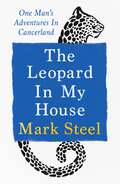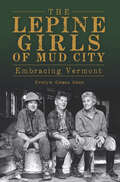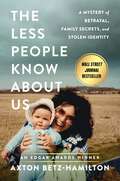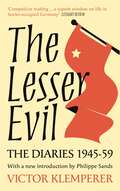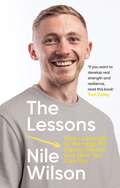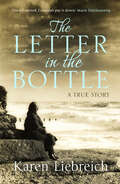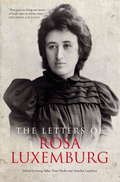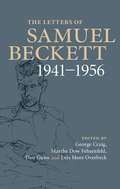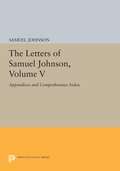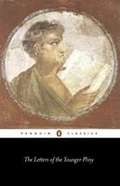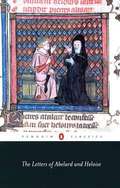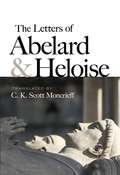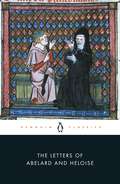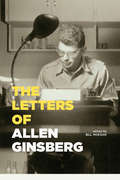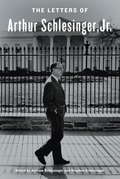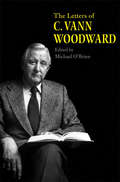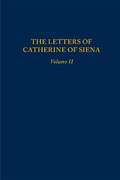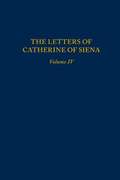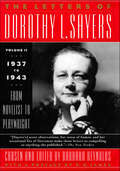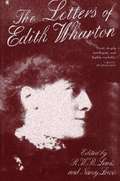- Table View
- List View
The Leopard in my House: One man’s adventures in cancerland
by Mark Steel'A deep, personal, clever and witty book' Michael Rosen | 'Funny, moving, wise and then very funny again' John O'Farrell | 'clear-eyed, humane and engaging' Observer | 'inspiring' GuardianI feel like there’s a leopard in my house, locked in a room. I’ve contacted the leopard authorities and they assure me they are used to dealing with leopards like this, and they have a plan for removing the leopard. It will take a while, though, and once in a while I can hear it growl.And that’s all very reassuring. Even so, several times a day I think to myself: “Hang on, there’s a leopard in my house.”One morning, while shaving, the comedian Mark Steel noticed that one side of his neck seemed larger than the other. After a whistlestop tour of assorted medical professionals, a consultant delivered the ominous words that would define the next months of his life: ‘I’m afraid it’s not good news, Mr Steel’.And so began a journey into the heart of the NHS, as he embarked on the long and uncertain road to cancer recovery via a range of mildly torturous and entirely miraculous treatments. What, if anything, might he learn about himself – and our capacity for coping with life when times get tough – as he becomes part of a club that one in two British people will ultimately join?A frank and funny diary of one man’s rather trying year, this is an unforgettable and uplifting story of getting ill, getting on with it, and getting better.
The Leper Spy: The Story of an Unlikely Hero of World War II
by Ben MontgomeryThe GIs called her Joey. Hundreds owed their lives to the tiny Filipina who stashed explosives in spare tires, tracked Japanese troop movements, and smuggled maps of fortifications across enemy lines. As the Battle of Manila raged, Josefina Guerrero walked through gunfire to bandage wounds and close the eyes of the dead. Her valor earned her the Medal of Freedom, but what made her a good spy was also destroying her: leprosy, which so horrified the Japanese they refused to search her. After the war, army chaplains found her in a nightmarish leper colony and fought for the US government to do something it had never done: welcome a foreigner with leprosy. This brought her celebrity, which she used to publicly speak for other sufferers. However, the notoriety haunted her and she sought a way to disappear. Ben Montgomery now brings Guerrero's heroic accomplishments to light.
The Lepine Girls of Mud City: Embracing Vermont
by Evelyn Earl GeerA biography of three sisters who grew up on the Vermont countryside, traveled the world, and returned to their farm to raise acclaimed cows.The Lepines&’ story began in Quebec, from where Maurice and Imelda immigrated to Vermont during the Great Depression. The family farmed, lived off the rich Vermont landscape and instilled a love for it in their daughters, Gert, Jeanette and Therese. As adults, &“the Girls&” taught school, traveled the world and worked for President Johnson but never forgot their roots. All three returned to Mount Sterling Farm, raising their famed Jersey cows and embodying Vermont&’s agricultural tradition. Their story is one of hope and valor—of a family who loved their home and neighbors and left their land as a lasting gift for the world.Praise for the Lepine Sisters&“The Lepine sisters . . . are the doyennes of rural northern Vermont. The sisters, and the Jersey cows they have been milking, feeding and cleaning up after for more than four decades, are what many Vermonters regard as the real Vermont.&” —New York Times
The Less People Know About Us: A Mystery of Betrayal, Family Secrets, and Stolen Identity
by Axton Betz-HamiltonIn this powerful true crime memoir, an award-winning identity theft expert tells the shocking story of the duplicity and betrayal that inspired her career and nearly destroyed her family. <P><P>Axton Betz-Hamilton grew up in small-town Indiana in the early '90s. When she was 11 years old, her parents both had their identities stolen. Their credit ratings were ruined, and they were constantly fighting over money. This was before the age of the Internet, when identity theft became more commonplace, so authorities and banks were clueless and reluctant to help Axton's parents. <P><P>Axton's family changed all of their personal information and moved to different addresses, but the identity thief followed them wherever they went. Convinced that the thief had to be someone they knew, Axton and her parents completely cut off the outside world, isolating themselves from friends and family. Axton learned not to let anyone into the house without explicit permission, and once went as far as chasing a plumber off their property with a knife. <P><P>As a result, Axton spent her formative years crippled by anxiety, quarantined behind the closed curtains in her childhood home. She began starving herself at a young age in an effort to blend in--her appearance could be nothing short of perfect or she would be scolded by her mother, who had become paranoid and consumed by how others perceived the family. <P><P>Years later, her parents' marriage still shaken from the theft, Axton discovered that she, too, had fallen prey to the identity thief, but by the time she realized, she was already thousands of dollars in debt and her credit was ruined. <P><P>The Less People Know About Us is Axton's attempt to untangle an intricate web of lies, and to understand why and how a loved one could have inflicted such pain. Axton will present a candid, shocking, and redemptive story and reveal her courageous effort to grapple with someone close that broke the unwritten rules of love, protection, and family.
The Lesser Evil: The Diaries of Victor Klemperer 1945-1959
by Victor KlempererThe superb, bestselling diaries of Victor Klemperer, a Jew in Dresden who survived the war - hailed as one of the 20th century's most important chronicles.'Compulsive reading' LITERARY REVIEW 'Deeply engrossing' SPECTATOR'Klemperer's diary deserves to rank alongside that of Anne Frank' SUNDAY TIMES'A vivid and powerful account of a remarkable life' SCOTLAND ON SUNDAYJune 1945. The immediate postwar period produces many shocks and revelations - some people have behaved better than Klemperer had believed, others much worse. His sharp observations are now turned on the East German Communist Party, which he himself joins, and he notes many similarities between Nazi and Communist behaviour. Politics, he comes to believe, is above all the choice of the "lesser evil". He serves in the GDR's People's Chamber and represents East German scholarship abroad. But it is the details of everyday life, and the honesty and directness, that make these bestselling diaries so fascinating.
The Lessons: How I learnt to Manage My Mental Health and How You Can Too
by Nile Wilson'If you want to develop real strength and resilience, read this book.' Tom DaleyNile Wilson has always been one of life's winners; a charismatic young man with an Olympic bronze medal in the Horizontal Bar at just 21 years old. But after a serious neck injury, forcing him to retire early and miss taking part in the Tokyo Olympics, Nile's world fell apart.Swamped with depression, anxiety and addictive behaviours, his mental health went over a cliff. Over the past few years, Nile has had to face down his demons and accept his new reality, and this is the book he wish he'd been given before it all began.Based on 15 hard-won lessons, Nile will guide you through the tools that have helped him come to back from the brink and find, for the first time, a sense of inner calm and renewed purpose. From recognizing destructive patterns, redefining success and managing self-talk, The Lessons will inspire and guide you through the ups and downs of life, and help you to build resilience and self-belief, no matter what.
The Letter Q: Queer Writers' Notes to Their Younger Selves
by James Lecesne Sarah MoonLife-saving letters from a glittering wishlist of top authors.If you received a letter from your older self, what do you think it would say? What do you wish it would say?That the boy you were crushing on in History turns out to be gay too, and that you become boyfriends in college? That the bully who is making your life miserable will one day become so insignificant that you won't remember his name until he shows up at your book signing?In this anthology, sixty-three award-winning authors such as Michael Cunningham, Amy Bloom, Jacqueline Woodson, Gregory Maguire, David Levithan, and Armistead Maupin make imaginative journeys into their pasts, telling their younger selves what they would have liked to know then about their lives as Lesbian, Gay, Bisexual, or Transgendered people. Through stories, in pictures, with bracing honesty, these are words of love and understanding, reasons to hold on for the better future ahead. They will tell you things about your favorite authors that you never knew before. And they will tell you about yourself.
The Letter in the Bottle
by Karen LiebreichOn a winter's day in 2002, a bottle shaped like a tear washed up on the Kent coast. It contained a letter written in French, a lock of hair, and a mystery. Only one thing could be known for certain—that the writer of the letter was a mother, grieving for her lost child, Maurice. Moved by the woman's heartache, Karen Liebreich sets out on an epic journey to piece together the mother's story. Her book is the amazing true story of one woman's search for another, and a poignant reflection on love, loss, and motherhood. In this revised edition Liebreich concludes her epic quest, finally meeting the woman who sent the bottle years before, and coming to understand the loss that was at the heart of one mother's impulse to communicate with the unknown.
The Letters Of Rosa Luxemburg
by Rosa Luxemburg George Shriver Annelies Laschitza Georg Adler Peter HudisThe most comprehensive collection of letters by Rosa Luxemburg ever published in English, this book includes 190 letters written to leading figures in the European and international labor and socialist movements--Leo Jogiches, Karl Kautsky, Clara Zetkin and Karl Liebknecht--who were among her closest friends, lovers and colleagues. Much of this correspondence appears for the first time in English translation; all of it helps to illuminate the inner life of this iconic revolutionary, who was at once an economic and social theorist, a political activist and a lyrical stylist. Her political concerns are revealed alongside her personal struggles within a socialist movement that was often hostile to independently minded women. This collection will provide readers with a newer and deeper appreciation of Luxemburg as a writer and historical figure.From the Trade Paperback edition.
The Letters Of Samuel Beckett, 1941-1956
by Samuel Beckett Martha Dow Fehsenfeld Lois More Overbeck George Craig Dan GunnThis second volume of The Letters of Samuel Beckett opens with the war years, when it was often impossible or too dangerous to correspond. The surge of letters beginning in 1945, and their variety, are matched by the outpouring and the range of Beckett's published work. Primarily written in French and later translated by the author, the work includes stories, a series of novels (Molloy, Malone meurt and L'Innommable), essays and plays - most notably En attendant Godot. The letters chronicle a passionately committed but little known writer evolving into a figure of international reputation, and his response to such fame. The volume provides detailed introductions which discuss Beckett's situation during the war and his crucial move into the French language, as well as translations of the letters, explanatory notes, year-by-year chronologies, profiles of correspondents and other contextual information.
The Letters Of Samuel Johnson, Volume V: Appendices And Comprehensive Index (Princeton Legacy Library #270)
by Bruce RedfordWith these two volumes Princeton University Press concludes the first scholarly edition of the letters of Samuel Johnson to appear in forty years. Volume IV chronicles the last three years of Johnson's life, an epistolary endgame that includes the breakup of the friendship with Hester Thrale and a poignant reaching out to new friends and new experiences. Volume V includes not only the comprehensive index but those undated letters that cannot confidently be assigned to a specific year, "ghost" letters (those whose existence is documented in other sources), three letters that have recently been recovered, and translations of Johnson's letters in Latin. Bruce Redford is Professor of English at the University of Chicago and the author of The Converse of the Pen: Acts of Intimacy in the Eighteenth-Century Familiar Letter (Chicago).
The Letters Of The Younger Pliny (Classics)
by Betty Radice Pliny the Pliny the YoungerProviding a series of fascinating views of Imperial Rome, The Letters of the Younger Pliny also offer one of the fullest self-portraits to survive from classical times. This Penguin Classics edition is translated with an introduction by Betty Radice. A prominent lawyer and administrator, Pliny was also a prolific letter-writer, who numbered among his correspondents such eminent figures as Tacitus, Suetonius and the Emperor Trajan, as well as a wide circle of friends and family. His lively and very personal letters address an astonishing range of topics, from a deeply moving account of his uncle's death in the eruption that engulfed Pompeii, to observations on the early Christians - 'a desperate sort of cult carried to extravagant lengths' - from descriptions of everyday life in Rome, with its scandals and court cases, to Pliny's life in the country. Betty Radice's definitive edition was the forst complete modern translation of Pliny's letters. In her introduction she examines the shrewd, tolerant and occasionally pompous man who emerges from these letters. Gaius Plinius Caecilius Secundus (c. 61-113), better known as Pliny the Younger, and nephew of Pliny the Elder, was born in Como, Italy. Beginning his career at the bar when he was eighteen, Pliny managed to emerge unscathed from Domitian's 'reign of terror', even being appointed an official at the treasury. In 103 he was awarded a priesthood in recognition of his distinguished public service, and was prominent in several major prosecutions. His nine books of personal letters were selected by Pliny himself and published during his lifetime, while his official correspondence with Trajan was published as a tenth book after his death and contains a celebrated exchange of letters on the early Christians. If you enjoyed The Letters of the Younger Pliny, you might like Tacitus' The Annals of Imperial Rome, also available in Penguin Classics.
The Letters of Abelard and Heloise
by M. T. Clanchy Betty RadiceThe story of the relationship between Abelard and Heloise is told through the letters of Peter Abelard, a French philosopher and one of the greatest logicians of the twelfth century, and of his gifted pupil Heloise. Through their impassioned writings unfolds the story of a romance, from its reckless, ecstatic beginnings through to public scandal, an enforced marriage and its devastating consequences. They also offer insight into religious life in the Middle Ages. This is the revised edition of Betty Radice's translation, in which Michael Clanchy, the biographer of Abelard, updates the scholarship on the letters and the lovers. This volume includes Abelard's autobiography and his spiritual advice to Heloise and her nuns, as well as a selection of the 'lost love letters' of Abelard and Heloise, letters between Heloise and Peter the Venerable, two of Abelard's hymns, a chronology, notes and maps.
The Letters of Abelard and Heloise
by C. K. MoncrieffAbelard, a prominent twelfth-century theologian, is hired to tutor Heloise, a brilliant pupil who becomes his lover and the mother of his child. Although the two are secretly married, a misunderstanding leads to Abelard's castration by Heloise's uncle, followed by the lovers' permanent separation. Abelard retreats to a monastery and Heloise to a nunnery — and their subsequent correspondence captured the romantic imaginations of generations of readers. The letters offer insights into the thinking of Abelard, who ranks among the Middle Ages' foremost philosophers, and the spirited determination of Heloise, an early feminist. They have also excited ongoing controversy in terms of their historical content and significance. Translator C. K. Scott Moncrieff takes a modern approach to the correspondence, adding new significance to its reflection of medieval attitudes toward love, marriage, and religion.
The Letters of Abelard and Heloise: Tr. From The Original Latin And Now Reprinted From The Edition Of 1722
by Peter AbelardThe story of Abelard and Heloise remains one of the world's most celebrated and tragic love affairs. Through their letters, we follow the path of their romance from its reckless and ecstatic beginnings when Heloise became Abelard's pupil, through the suffering of public scandal and enforced secret marriage, to their eventual separation.
The Letters of Allen Ginsberg
by Bill Morgan Allen GinsbergThe best of poet Allen GinsbergOCOs correspondence with friends like Jack Kerouac and William S. Burroughs, edited by the authorOCOs longtime literary archivist. "
The Letters of Arthur Schlesinger, Jr.
by Arthur Schlesinger Stephen C. Schlesinger Andrew SchlesingerThis extraordinary collection gathers the never-before-seen correspondence of a true American original--the acclaimed historian and lion of the liberal establishment, Arthur Schlesinger, Jr. An advisor to presidents, two-time Pulitzer Prize winner, and tireless champion of progressive government, Arthur Schlesinger, Jr., was also an inveterate letter writer. Indeed, the term "man of letters" could easily have been coined for Schlesinger, a faithful and prolific correspondent whose wide range of associates included powerful public officials, notable literary figures, prominent journalists, Hollywood celebrities, and distinguished fellow scholars. The Letters of Arthur Schlesinger, Jr. reveals the late historian's unvarnished views on the great issues and personalities of his time, from the dawn of the Cold War to the aftermath of September 11. Here is Schlesinger's correspondence with such icons of American statecraft as Harry Truman, Adlai Stevenson, Hubert Humphrey, Henry Kissinger, Bill Clinton, and, of course, John and Robert Kennedy (including a detailed critique of JFK's manuscript for Profiles in Courage). There are letters to friends and confidants such as Eleanor Roosevelt, John Kenneth Galbraith, Gore Vidal, William Styron, and Jacqueline Kennedy (to whom Schlesinger sends his handwritten condolences in the hours after her husband's assassination), and exchanges with such unlikely pen pals as Groucho Marx, Sammy Davis, Jr., and Bianca Jagger. Finally, there are Schlesinger's many thoughtful replies to the inquiries of ordinary citizens, in which he offers his observations on influences, issues of the day, and the craft of writing history. Written with the range and insight that made Schlesinger an indispensable figure, these letters reflect the evolution of his thought--and of American liberalism--from the 1940s to the first decade of the new millennium. Whether he is arguing against the merits of preemptive war, advocating for a more forceful policy on civil rights, or simply explaining his preference in neckwear ("For sloppy eaters bow ties are a godsend"), Schlesinger reveals himself as a formidable debater and consummate wit who reveled in rhetorical combat. To a detractor who accuses him of being a Communist sympathizer, he writes: "If your letter was the product of sincere misunderstanding, the facts I have cited should relieve your mind. If not, I can only commend you to the nearest psychiatrist." Elsewhere, he castigates a future Speaker of the House, John Boehner, for misattributing quotations to Abraham Lincoln. Combining a political strategist's understanding of the present moment with a historian's awareness that the eyes of posterity were always watching him, Arthur Schlesinger, Jr., helped shape the course of an era with these letters. This landmark collection frames the remarkable dynamism of the twentieth-century and ensures that Schlesinger's legacy will continue to influence this one.Advance praise for The Letters of Arthur Schlesinger, Jr. "Arthur Schlesinger's letters are full of personal, political, and historical insights into the tumultuous events and enormous personalities that dominated the mid-twentieth century. Because he viewed them up close but with a historian's perspective, The Letters of Arthur Schlesinger, Jr. helps us all to more fully understand recent history."--President Bill Clinton
The Letters of C. Vann Woodward
by C. Vann Woodward Michael O'BrienC. Vann Woodward was one of the most prominent and respected American historians of the twentieth century. He was also a very gifted and frequent writer of letters, from his earliest days as a young student in Arkansas and Georgia to his later days at Yale when he became one of the arbiters of American intellectual culture. For the first time, his sprightly, wry, sympathetic, and often funny letters are published, including those he wrote to figures as diverse as John Kennedy, David Riesman, Richard Hofstadter, and Robert Penn Warren. The letters shed new light not only on Woodward himself, but on what it meant to be an American radical and public intellectual, as well as on the complex politics and discourse of the historical profession and the anxious modulations of Southern culture.
The Letters of Catherine of Siena (Volume #2)
by Catherine Of SienaThe second volume takes up Catherine's (1347-80) letters in February 1376, as she is making plans for her mission to the pope in Avignon. They continue through that trip to Florence and Avignon and back, time back in Siena and Belcaro, and her mission to the Val D'Orcia, and end in November or December 1377. Each chronological section and each letter itself is introduced, often at some length. An appendix identifies people she mentions or are mentioned in the introductions, and refers by number to all the letters in the volume that mentions them. Translation, notes and introduction by Suzanne Noffke.
The Letters of Catherine of Siena (Volume #4)
by Catherine Of SienaThe final volume in the letters of this medieval saint, the first woman declared a Doctor of the Church. Translated, with notes and introduction, by Suzanne Noffke.
The Letters of Cole Porter
by Cole PorterThe first comprehensive collection of the letters of one of the most successful American songwriters of the twentieth century From Anything Goes to Kiss Me, Kate, Cole Porter left a lasting legacy of iconic songs including "You're the Top," "Love For Sale," and "Night and Day." Yet, alongside his professional success, Porter led an eclectic personal life which featured exuberant parties, scandalous affairs, and chronic health problems. This extensive collection of letters (most of which are published here for the first time) dates from the first decade of the twentieth century to the early 1960s and features correspondence with stars such as Irving Berlin, Ethel Merman, and Orson Welles, as well as his friends and lovers. Cliff Eisen and Dominic McHugh complement these letters with lively commentaries that draw together the loose threads of Porter&’s life and highlight the distinctions between Porter&’s public and private existence. This book reveals surprising insights into his attitudes toward Hollywood and Broadway, and toward money, love, and dazzling success.
The Letters of Dorothy L. Sayers, Volume II: 1937 to 1943: From Novelist to Playwright (The Letters of Dorothy L. Sayers)
by Dorothy L. SayersThis second volume of Dorothy L. Sayers covers the seven years in which the greatest detective novelist of the golden age--and the creator of Lord Peter Wimsey--turns away from mystery writing to become a playwright and, in turn, a controversial figure.Accused on the one hand of blasphemy, acclaimed on the other as one of the most influential lay theologians of her time, she found herself drawn into a vast network of correspondence, dealing with a wide range of social concerns.These, after all, are the years of World War II, of air-raids, threats of invasion, rationing, lack of domestic help, congested travel, and blackouts. But there was no blackout in the creativity of Dorothy L. Sayers; in fact, this is the peak period f her creative endeavors: seventeen plays, several books, innumerable articles and talks--and hundreds of letters.The letters reveal the context of her published words and send the reader back to them with new understanding. But the issues they raise are not merely those of her time; many are startlingly topical, even today. The letters take us behind the scenes of her thinking, activity, and personal life. Here is an unknown Dorothy L. Sayers, whose influence on her contemporaries and beyond has yet to be measured. But at the same time, here is the Sayers whom we have always known and loved: witty, engaging, creative, passionate, committed. Barbara Reynolds, Dorothy L. Sayers's acclaimed biographer, has selected and annotated these letters from the hundreds that Sayers wrote during one of the most fascinating times of her life.
The Letters of Dorothy Wordsworth
by Dorothy Wordsworth Alan G. Hill"I should detest," wrote Dorothy Wordsworth, "the idea of setting myself up as an author." Protesting to Lady Beaumont she explained "I have not the powers which Coleridge thinks I have--I know it."
The Letters of Edith Wharton
by Edith WhartonA careful selection, including Wharton's "major" letters that are often quoted, and for the first time, a substantial portion of her correspondence with Morton Fullerton, with whom she had an affair while in her mid-40s.
